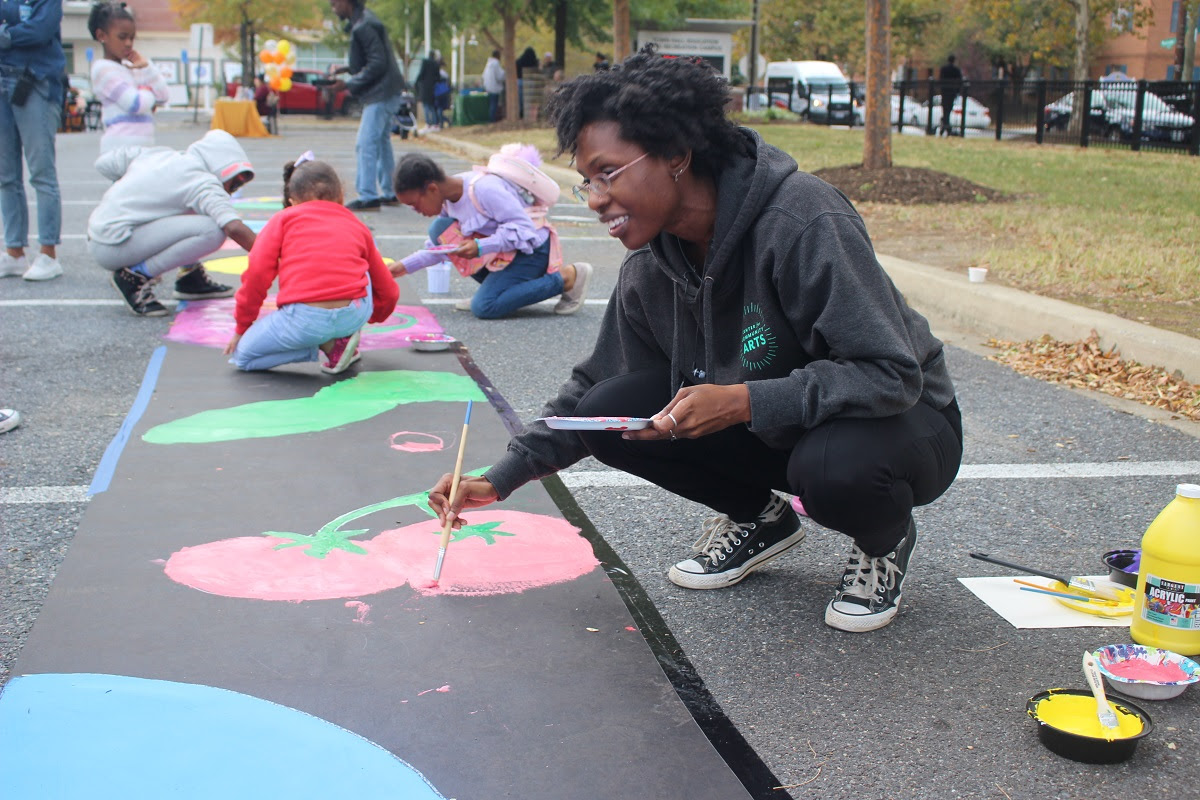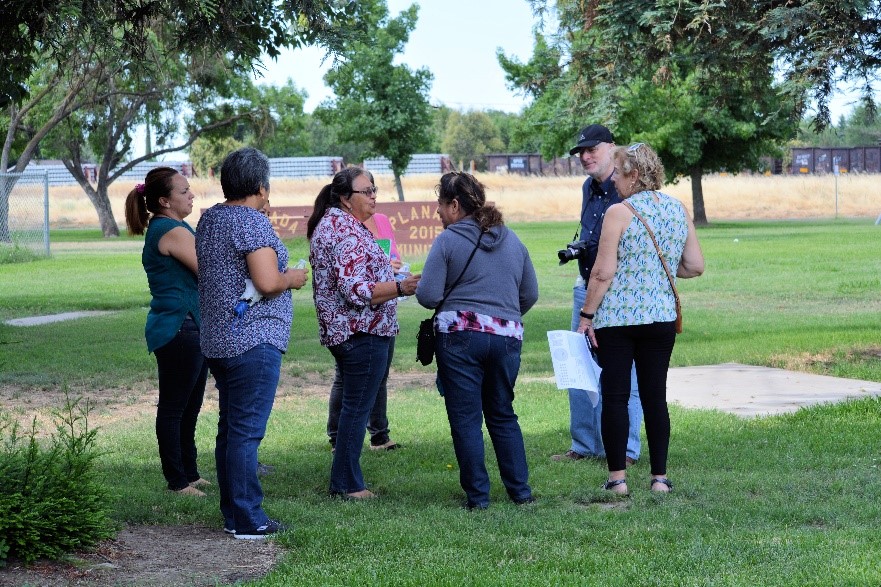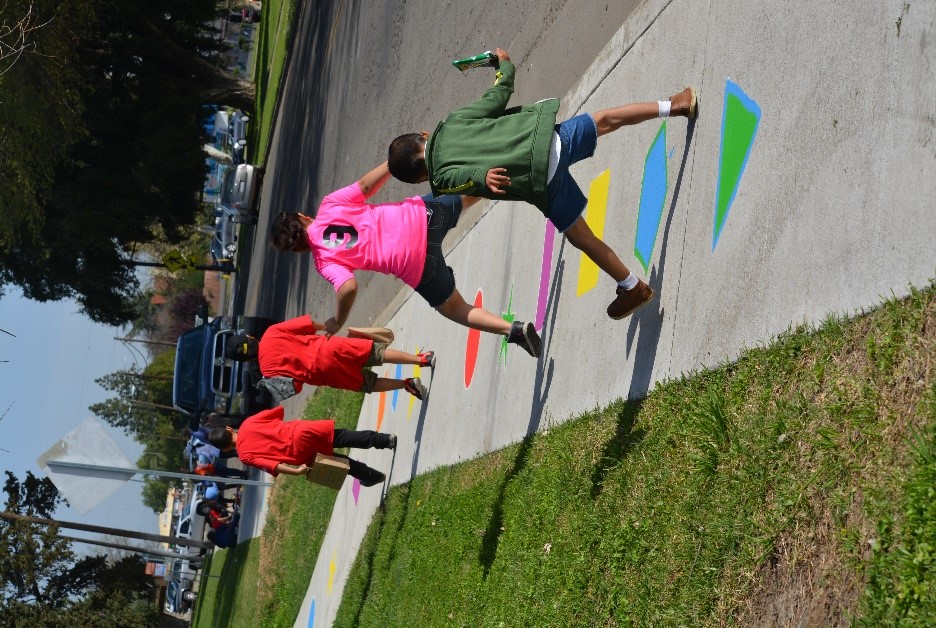This blog post was written by Margaux Mennesson, Marisa Jones, Michelle Lieberman, Margo Pedroso and Cass Isidro.
Over the last several months, the COVID-19 pandemic and protests for racial justice and against police brutality have prompted our team at the Safe Routes Partnership to critically examine many of the systems, strategies, and programs that support Safe Routes.
While racial justice and equity have long been core values of our organization, we also recognize that making a commitment to anti-racism requires ongoing self-reflection, listening, and doubling down on our efforts to understand the racism that is embedded in public health and transportation systems. As a result of this work, and with collaboration and support from our partners in the field, we recently announced an update to the 6 E’s framework of Safe Routes to School, dropping “Enforcement” entirely and adding “Engagement” as the leading E.
We received a great deal of feedback about the announcement, with the majority expressing support for this change along with some practical questions about the role of Engagement and how to keep kids safe as Safe Routes to School programs move forward. This blog post is the first of a series we will be releasing over the next few months to dive deeply into each component of a Safe Routes to School program in the context of the updated framework. For more information on the impacts of the COVID-19 pandemic on Safe Routes to School, we have recommendations forthcoming from the Back to School 2020 Work Group. We will also offer learning and discussion webinars to support each of you in making connections and developing your programs in light of current events and developments.
Community engagement is about relationship-building. How can we create opportunities to authentically connect with one another? Be curious. Be open. Be a listener. Be authentic. Be creative.
– Kori Johnson, Safe Routes Partnership Community Engagement Manager, Engaging Your Community in Safe Routes to School Programs
Why Lead with Engagement?

Residents of Washington, DC's Ward 8 community collaborated with DC Community Engagement Manager Kori Johnson to design and implement youth-led, culturally responsive traffic safety initiatives to advance Vision Zero.
ENGAGEMENT – All Safe Routes to School initiatives should begin by listening to students, families, teachers, and school leaders; working with existing community organizations; and building intentional, ongoing engagement opportunities into the program structure.
Historically, marginalized people and populations made vulnerable by the legacy of harmful and racist policy and funding decisions, including Black, indigenous, and people of color (BIPOC) communities, low-income communities, older adults, youth, and people with disabilities have been left out of transportation and planning decision making processes. This is true for decisions at every level, from the development of the federal highway system in the 1950s and 60s that intentionally decimated Black-owned businesses and displaced Black communities across the United States, to seemingly minor surface-level street changes today that bring convenience or desired change to one group of people at the expense of another. The consequences of failing to engage the community from the outset of any initiative are manifold. Without genuine community engagement, even a well-intentioned project could cause major disruption to the lives and livelihood of people in your community. Lackluster community engagement that aims to “check the box” on community engagement could overlook the needs of historically marginalized populations, deter people from supporting Safe Routes to School, require backtracking that costs your program precious time and resources, and further erode community trust. The harms of low or no community engagement may be less obvious to those not looking for them, like participation in Safe Routes to School programs that do not reflect the racial, ethnic, or socioeconomic diversity of your community/school district because they are led by people whose lived experiences do not match those of the student population. This is among the most insidious forms of failing to engage community members because on the surface it appears that a program is successful, but for whom?
The good news is that these outcomes can be largely avoided by making meaningful community engagement a key component of every Safe Routes to School program. For this reason, the Safe Routes Partnership has identified Engagement as the leading E of the Safe Routes to School framework and the foundation upon which all Safe Routes to Schools programs should be built and strengthened. The benefits of true community engagement in Safe Routes to School include:
- More vibrant, creative programs. Diverse perspectives, cultures, and upbringings are things to be celebrated and highlighted in Safe Routes to School programming, not managed or incorporated into mainstream culture.
- Increased inclusivity and participation among the entire school community. When various perspectives are involved and listened to and programs grow, develop and evolve with different lived experiences in mind, programs feel more accessible to people from all walks of life.
- Stronger buy-in, community champions, and ownership of changes. When community members are involved early in the process, it leads to a greater sense of ownership of a project or outcome.
- Stronger, more trusting relationships with the community that will benefit not only your Safe Routes to School program, but can lay the groundwork for lasting partnerships and lead to mutual support for future efforts.
- Using resources more efficiently and effectively. By involving community members’ perspectives early on, your program and community can avoid spending money on solutions that do not meet the community’s actual needs.
Authentic community engagement is critical to ensuring that your program outcomes are successful and sustainable in the long run – not just in terms of objective measures of success, such as increased rates of walking and biking and better safety outcomes, but also in making sure the program reflects the racial, ethnic, and socioeconomic diversity of your community and school district.
Community Engagement in Action


Community residents of Planada-Mujeres Poderosas in Planada, California, collaborated with Cultiva La Salud to lead a Safe Routes to Parks project aimed at improving walking and biking access to a local park. With years of relationship-building and trusted partnerships already established between residents and the community organization, the project was largely guided by community members who organized planning meetings, walk audits, and several design forums aimed at building consensus around shared goals and priorities. Photo credit: Cultiva La Salud
Outreach or Engagement?
Engagement is a broad term with many possible interpretations, and it is often used interchangeably with the term outreach. In practice, there are important distinctions between engagement and outreach. Those of you who attended the 2019 Safe Routes to School National Conference may recall when plenary speaker Shavon Arline-Bradley asked the audience to share examples of their community engagement strategies. Some of the common features included:
- Acknowledging the community’s presence and diverse perspectives
- Convening focus groups and community town halls
- Providing childcare, translation, and other supportive resources to make it possible for the community to attend meetings and events
- Offering incentives for participation
These efforts have value and should certainly be part of every Safe Routes to School program’s engagement toolbox, but Ms. Arline-Bradley rightly pointed out that these outreach tactics fall short of authentic community engagement. Outreach is directed and led by the group with decision making power; it is transactional, benefitting one side more than the other. Outreach may include opportunities for listening and having a two-way dialogue, but it is short-term, and there is usually no commitment to honoring opposing viewpoints or sharing decision-making authority.
Ms. Arline-Bradley challenged Safe Routes to School programs and practitioners to work harder to create meaningful engagement opportunities in order to advance racial justice and grow truly comprehensive, inclusive, and equitable programs. Engagement begins first and foremost with listening and asking questions – of the community and of yourself. Engagement thrives on diversity and inclusion; values all voices and perspectives; and builds long-term relationships that lead to mutual support for shared goals. A robust engagement strategy includes efforts to:
- Make space. Invite members of the community to participate in Safe Routes to School planning and programming and actively prepare a space for them on your team. As you extend invitations to community members, be clear about how their perspective will inform the outcomes of the project and explain how you are prepared to offer mutual support for shared community goals.
- Step back. Recognize that sometimes, despite passion, content expertise, and experience, you are not the best person to lead a conversation or activity in or with a particular community. It can be more effective and respectful to let others with authentic ties to a particular community or neighborhood lead conversations, planning processes, and even programming.
- Show up for issues not related to Safe Routes to School. Attend meetings of community organizations, even when they are considering issues not relevant to Safe Routes to School, to listen, understand needs, assist with their needs, and build relationships. Ask for input about Safe Routes to School at existing community meetings and events so you aren’t requiring people to attend another meeting to share their thoughts.
- Collaborate. Commit to making collaborative decisions with the input and full voice of community members.
- Share (or relinquish) decision making power. Give community members the decision making authority to chart the course of Safe Routes to School plans and programs and effectuate change in community.
- Value differences. People experience life differently, and all lived experiences are valid. True community engagement aims to recognize, validate, and plan for the breadth of lived experiences rather than attempt to amalgamate them.
- Invest for the long-run. Make investments that go beyond gifts and incentives. For example, provide skill development training, financing for joint community initiatives, share materials and supplies that can be used for other types of community events, etc.
Meaningful community engagement will inform and shape each element of the 6 E’s framework that guides your Safe Routes to School program.
- Equity: We don’t know what we don’t know. We need to listen to people whose lived experiences are different from our own and appreciate them as true and valid, even if it causes discomfort. Building a diverse and robust community engagement program is key to ensuring that your Safe Routes to School program supports safe, healthy, and fair outcomes for students of color, students of all genders, students with disabilities, and others. Is your stakeholder team missing any key representatives from the community? In some cases, it may be more effective for a trusted community member to connect with people whose voices are missing and invite them to participate.
- Engineering: Do the proposed engineering changes serve all populations, including students and people with disabilities? Have neighbors noticed any unsafe driving behaviors that should be considered as part of a Safe Routes to School engineering project? Would these changes inadvertently affect people’s ability to get to critical services, grocery stores, places of faith, or jobs? Will engineering changes prioritize the areas of the community most in need of improvements? If there is pushback from the community to planned improvements, is there opportunity to listen and make changes before breaking ground?
- Encouragement: Kids (and adults!) want to see people like them doing the things that they want to do. Who do students of color, with disabilities, of various sexualities and genders admire, or who are the leaders in those communities that students look up to? Invite them to participate in Walk to School Day. Are there members of the community who are interested in helping with–or better yet, leading–encouragement efforts? Local business owners may provide incentives, neighbors may be interested in volunteering and/or spreading the word about an event like Walk to School Day. How can Safe Routes give back to community members who offer their support?
- Education: Many Safe Routes programs focus on teaching students the rules of the road through bicycle and pedestrian safety education curricula, but community education is also an important component of Safe Routes to School education programs. What are the most effective ways to educate the community? Is your information reaching all community members where they are – whether that is online or offline—and in the languages commonly spoken in the community? Messengers matter, too. Look to the community as you determine who the best person to share this information with students is. Younger children may want information to come from teachers, parents, and trusted adults, while middle school and older students prefer to get information from peers and youth leaders.
- Evaluation: Evaluation is an ongoing process that should take place throughout the duration of the program. Evaluation is part of agenda-setting, so the community should be involved in identifying what they want to measure in order to assess the program’s success. Does the community want to see an increase in walking and biking rates? Fewer instances of traffic violations? Bear in mind that qualitative data, like community perceptions of safety, matter just as much as quantitative data like school travel tallies. Work with community members to identify how to incorporate and truly value qualitative data.
In the coming weeks and months, we will continue to share actionable steps, tools, and best practices for building or strengthening your community engagement strategy. We are interested in hearing from practitioners and advocates in the field; your experiences and success stories will inform our guidance as we develop resources for Safe Routes programs at every level. We invite you to connect with us at info@saferoutespartnership.org.
Reading List and Resources
- Community Engagement Cards
- Equitable Community Engagement in the Time of Social Distancing
- A Checklist for Facilitating Community Engagement During Safe Routes to Parks Visioning Activities
- Safe Routes for Youth: Supporting and Empowering Teen Leaders in Vision Zero
- Webinar: Moving Forward Together: Engaging Your Community in Safe Routes to School Programs
- Webinar: Winning Strategies to Engage Diverse Communities in Safe Routes to School

